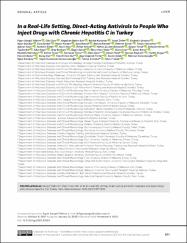In a real-life setting, direct-acting antivirals to people who inject drugs with chronic hepatitis c in Turkey

Göster/
Erişim
info:eu-repo/semantics/openAccessTarih
2022Yazar
Yıldırım, FigenÜser, Ülkü
Sarı, Nagehan Didem
Kurtaran, Behice
Önlen, Yusuf
Senateş, Ebubekir
Gündüz, Alper
Zerdali, Esra
Karsen, Hasan
Batırel, Ayşe
Karaali, Rıdvan
Güner, Rahmet
Yamazhan, Tansu
Köse, Şükran
Erben, Nurettin
İnce, Nevin
Köksal, İftihar
Çuvalcı Öztoprak, Nefise
Yörük, Gülşen
Kömür, Süheyla
Bal, Tayibe
Kaya, Sibel
Bozkurt, İlkay
Günal, Özgür
Yıldız, İlknur Esen
İnan, Dilara
Barut, Şener
Hızel, Kenan
Baykam, Nurcan
Duygu, Fazilet
Bodur, Hürrem
Can, Güray
Gül, Hanefi Cem
Sağmak Tartar, Ayşe
Çelebi, Güven
Sünnetçioğlu, Mahmut
Karabay, Oğuz
Kumbasar Karaosmanoğlu, Hayat
Sırmatel, Fatma
Üst veri
Tüm öğe kaydını gösterKünye
Sarıgül Yıldırım, F., Üser, Ü., Sarı, N. D., Kurtaran, B., Önlen, Y., Şenateş, E., Gündüz, A., Zerdali, E., Karsen, H., Batırel, A., Karaali, R., Güner, R., Yamazhan, T., Köse, Ş., Erben, N., İnce, N., Köksal, İ., Çuvalcı Öztoprak, N., Yörük, G., Kömür, S., … Tabak, F. (2022). In a Real-Life Setting, Direct-Acting Antivirals to People Who Inject Drugs with Chronic Hepatitis C in Turkey. The Turkish journal of gastroenterology : the official journal of Turkish Society of Gastroenterology, 33(11), 971–978. https://doi.org/10.5152/tjg.2022.21834Özet
Background: People who inject drugs (PWID) should be treated in order to eliminate hepatitis C virus in the world. The aim of this study
was to compare direct-acting antivirals treatment of hepatitis C virus for PWID and non-PWID in a real-life setting.
Methods: We performed a prospective, non-randomized, observational multicenter cohort study in 37 centers. All patients treated with
direct-acting antivirals between April 1, 2017, and February 28, 2019, were included. In total, 2713 patients were included in the study
among which 250 were PWID and 2463 were non-PWID. Besides patient characteristics, treatment response, follow-up, and side effects
of treatment were also analyzed.
Results: Genotype 1a and 3 were more prevalent in PWID-infected patients (20.4% vs 9.9% and 46.8% vs 5.3%). The number of naïve
patients was higher in PWID (90.7% vs 60.0%), while the number of patients with cirrhosis was higher in non-PWID (14.1% vs 3.7%). The
loss of follow-up was higher in PWID (29.6% vs 13.6%). There was no difference in the sustained virologic response at 12 weeks after
treatment (98.3% vs 98.4%), but the end of treatment response was lower in PWID (96.2% vs 99.0%). In addition, the rate of treatment
completion was lower in PWID (74% vs 94.4%).
Conclusion: Direct-acting antivirals were safe and effective in PWID. Primary measures should be taken to prevent the loss of follow-up
and poor adherence in PWID patients in order to achieve World Health Organization’s objective of eliminating viral hepatitis.

















